A new species of Enteromius from the Bale Mountain Region, southeastern Ethiopia (Teleostei: Cyprinidae)
Received 16 October 2020
Revised 28 December 2020
Accepted 11 August 2021
Published 5 November 2021
ZooBank LSID:
urn:lsid:zoobank.org:pub:AD92A600-F9D9-4E85-94BE-DFD6E89BACEA
German National Library URN:
urn:nbn:de:101:1-2021110513511156423666
DOI:
10.23788/IEF-1161
14,50 €
Aljanabi, S. M. & I. Martinez. 1997. Universal and rapid salt-extraction of high quality genomic DNA for PCR-based techniques. Nucleic Acids Research, 25: 4692-4693.
Armbruster, J. W., C. C. Stout & M. M. Hayes. 2016. An empirical test for convergence using African barbs (Cypriniformes: Cyprinidae). Evolutionary Ecology, 30: 435-450.
Berrebi, P., M. Kottelat, P. Skelton & P. Ráb. 1996. Systematics of Barbus: state of the art and heuristic comments. Folia Zoologica, 45 (Supplement 1): 5-12.
Beshera, K. A., P. M. Harris & R. L. Mayden. 2016. Novel evolutionary lineages in Labeobarbus (Cypriniformes; Cyprinidae) based on phylogenetic analyses of mtDNA sequences. Zootaxa, 4093: 363-381.
Conway, K. W. & T. Moritz. 2006. Barboides britzi, a new species of miniature cyprinid from Benin (Ostariophysi: Cyprinidae), with a neotype designation for B. gracilis. Ichthyological Exploration of Freshwaters, 17: 73-84.
Conway, K. W. & M. L. J. Stiassny. 2008. Phylogenetic diagnosis of the African cyprinid genus Clypeobarbus (Ostariophysi: Cyprinidae), with the rehabilitation of Clypeobarbus bomokandi. Ichthyological Research, 55: 260-266.
Darriba, D., G. L. Taboada, R. Doallo & D. Posada. 2012. jModelTest 2: more models, new heuristics and parallel computing. Nature Methods, 9: 772.
De Graaf, M., H.-J. Megens, J. Samallo & F. A. Sibbing. 2007. Evolutionary origin of Lake Tana’s (Ethiopia) small Barbus species: indications of rapid ecological divergence and speciation. Animal Biology, 57: 39-48.
Elmi Mohamed, A. 2013. Managing shared river basins in the Horn of Africa: Ethiopian planned water projects on the Juba and Shabelle rivers and effects on downstream uses in Somalia. Pp. 139-151 in: Brebbia, C. A. (ed.), River Basin Management VII, WIT Press, Ashurst Lodge.
Englmaier, G. K., Genanaw Tesfaye & N. G. Bogutskaya. 2020. A new species of Enteromius (Actinopterygii, Cyprinidae, Smiliogastrinae) from the Awash River, Ethiopia, and the re-establishment of E. akakianus. ZooKeys, 902: 107-150.
Fricke, R., W. N. Eschmeyer & R. van der Laan. 2021. Catalog of fishes: genera, species, references. Available from http://researcharchive.calacademy.org/research/ichthyology/catalog/fishcatmain.asp. (accessed 1 February 2021).
Golubtsov, A. S. & P. B. Berendzen. 2005. A review of the small barbs (Barbus, Cyprinidae) with a serrated dorsal spine from Ethiopia, with a discussion of the origin of forms with a reduced dorsal spine from the White Nile and Omo River tributaries. Journal of Ichthyology, 45 (Supplement 1): S58-S88.
Golubtsov, A. S., Y. Y. Dgebuadze & M. V. Mina. 2002. Fishes of the Ethiopian Rift Valley. Pp. 167-258 in: C. Tudorancea, W. D. Taylor, G. Baele & M. A. Suchard, (eds.), Ethiopian Rift Valley Lakes. Biology of Inland Waters Series. Backhuys, Leiden.
Golubtsov, A. S., N. B. Korostelev & B. A. Levin. 2021. Monsters with a shortened vertebral column: A population phenomenon in radiating fish Labeobarbus (Cyprinidae). PLoS ONE 16: e0239639.
Golubtsov, A. S. & E. Y. Krysanov. 1993. Karyological study of some cyprinid species from Ethiopia: the ploidy differences between large and small Barbus of Africa. Journal of Fish Biology, 42: 445-455.
Golubtsov, A. S. & E. Y. Krysanov. 2003. Karyological comparison of the small African barbs Barbus paludinosus (Cyprinidae) with developed and reduced spine in the dorsal fin. Journal of Ichthyology, 43: 245-252.
Golubtsov, A. S., P. H. Skelton, K. M. Shidlovsky, E. R. Swartz & E. Y. Krysanov. 2004. The discovery of a Pseudobarbus-like barb in the Bale mountain region, Ethiopia: an ancient trace of endemic South-African cyprinids in the Horn of Africa? Pp. 108-109 in: XI European Congress of Ichthyology, September 6-10, 2004, Tallinn.
Gouy, M., S. Guindon & O. Gascuel. 2009. SeaView version 4: a multiplatform graphical user interface for sequence alignment and phylogenetic tree building. Molecular Biology and Evolution, 27: 221-224.
Greenwood, P. H. 1962. A revision of certain Barbus species (Pisces, Cyprinidae) from east, central, and south Africa. Bulletin of the British Museum (Natural History). Zoology, 8: 151-208.
Guindon, S., J.-F. Dufayard, V. Lefort, M. Anisimova, W. Hordijk & O. Gascuel. 2010. New algorithms and methods to estimate maximum-likelihood phylogenies: assessing the performance of PhyML 3.0. Systematic Biology, 59: 307-321.
Hayes, M. M. & J. W. Armbruster. 2017. The taxonomy and relationships of the African small barbs (Cypriniformes: Cyprinidae). Copeia, 105: 348-362.
Helaers, R. & M. C. Milinkovitch. 2010. MetaPIGA v2.0: maximum likelihood large phylogeny estimation using the metapopulation genetic algorithm and other stochastic heuristics. BMC Bioinformatics, 11: 379.
Jakubowski, M. 1970. [Methods of revealing and coloring of canal system in lateral line and bone elements in fish]. Zoologichesky Zhurnal, 49: 1398-1401 [in Russian].
Kumar, S., G. Stecher & K. Tamura. 2016. MEGA7: molecular evolutionary genetics analysis version 7.0 for bigger datasets. Molecular Biology and Evolution, 33: 1870-1874.
Lanfear, R., B. Calcott, S. Y. W. Ho & S. Guindon. 2012. PartitionFinder: combined selection of partitioning schemes and substitution models for phylogenetic analyses. Molecular Biology and Evolution, 29: 1695-1701.
Lévêque, C. & J. Daget 1984. Cyprinidae. Pp. 217-342 in: J, Daget, J. P. Gosse & D. F. E. Thys van den Audenaerde (eds.), Check-list of the freshwater fishes of Africa. Volume 1. ISNB, Bruxelles; MRAC, Tervuren & ORSTOM, Paris.
Levin, B. A., J. Freyhof, Z. Lajbner, S. Perea, A. Abdoli, M. Gaffarog˘lu, M. Özulug˘, H. R. Rubenyan, V. B. Salnikov & I. Doadrio. 2012. Phylogenetic relationships of the algae scraping cyprinid genus Capoeta (Teleostei: Cyprinidae). Molecular Phylogenetics and Evolution, 62: 542-549.
Machordom, A. & I. Doadrio. 2001. Evolutionary history and speciation modes in the cyprinid genus Barbus. Proceedings of the Royal Society of London B: Biological Sciences, 268: 1297-1306.
Minh, B. Q., M. A. T. Nguyen & A. von Haeseler. 2013. Ultrafast approximation for phylogenetic bootstrap. Molecular Biology and Evolution, 30: 1188-1195.
Palumbi, S. R. 1996. Nucleic acids II: the polymerase chain reaction. Pp. 205-247 in: D. M. Hillis, C. Moritz & B. K. Mable (eds.), Molecular Systematics. Second edition. Sinauer, Sunderland.
Paugy, G. 2010. The Ethiopian subregion fish fauna: an original patchwork with various origins. Hydrobiologia, 649: 301-315.
Perdices, A., E. Bermingham, A. Montilla & I. Doadrio. 2002. Evolutionary history of the genus Rhamdia (Teleostei: Pimelodidae) in Central America. Molecular Phylogenetics and Evolution, 25: 172-189.
Pethiyagoda, R., M. Meegaskumbura & K. Maduwage. 2012. A synopsis of the South Asian fishes referred to Puntius (Pisces: Cyprinidae). Ichthyological Explorations of Freshwaters, 23: 69-95.
Rambaut, A. 2017. FigTree-version 1.4. 3, a graphical viewer of phylogenetic trees. Available from http://tree.bio.ed.ac.uk/software/
Rambaut, A., M. A. Suchard, D. Xie & A. J. Drummond. 2014. Tracer 1.6. Available from http://beast.bio.ed.ac.uk/Tracer
Redeat Habteselassie. 2012. Fishes of Ethiopia: annotated checklist with pictorial identification guide. Ethiopian Fisheries and Aquatic Science Association, Addis-Ababa, 250 pp.
Ren, Q. & R. L. Mayden. 2016. Molecular phylogeny and biogeography of African diploid barbs, “Barbus”, and allies in Africa and Asia (Teleostei: Cypriniformes). Zoologica Scripta, 45: 642-649.
Ronquist, F. & J. P. Huelsenbeck. 2003. MrBayes 3: Bayesian phylogenetic inference under mixed models. Bioinformatics, 19: 1572-1574.
Saitoh, K., T. Sado, R. L. Mayden, N. Hanzawa, K. Nakamura, M. Nishida & M. Miya. 2006. Mitogenomic evolution and interrelationships of the Cypriniformes (Actinopterygii: Ostariophysi): the first evidence toward resolution of higher-level relationships of the world’s largest freshwater fish clade based on 59 whole mitogenome sequences. Journal of Molecular Evolution, 63: 826-841.
Schmidt, R. C., H. L. Bart Jr. & W. D. Nyingi. 2017. Multilocus phylogeny reveals instances of mitochondrial introgression and unrecognized diversity in Kenyan barbs (Cyprininae: Smiliogastrini). Molecular Phylogenetics and Evolution, 111: 35-43.
Shibru Tedla & Fisseha Haile Meskel. 1981. Introduction and transplantation of freshwater fish species in Ethiopia. SINET: Ethiopian Journal of Science, 4: 69-72.
Skelton, P. H. 1980. Systematics and biogeography of the redfin Barbus species (Pisces: Cyprinidae) from southern Africa. PhD dissertation, Rhodes University, Grahamstown, ix + 416 pp.
Skelton, P. H. 1988. A taxonomic revision of the redfin minnows (Pisces, Cyprinidae) from southern Africa. Annals of the Cape Provincial Museum (Natural History), 16: 201-307.
Skelton, P. H., E. R. Swartz & E. J. Vreven. 2018. The identity of Barbus capensis Smith, 1841 and the generic status of southern African tetraploid cyprinids (Teleostei, Cyprinidae). European Journal of Taxonomy, 410: 1-29.
Stiassny, M. L. J. & H. Sakharova. 2016. Review of the smiliogastrin cyprinids of the Kwilu River (Kasai Basin, central Africa), revised diagnosis for Clypeobarbus (Cyprinidae: Cyprininae: Smiliogastrini) and description of a new species. Journal of Fish Biology, 88: 1394-1412.
Taki, Y., A. Katsuyama & T. Urushido. 1978. Comparative morphology and interspecific relationships of the cyprinid genus Puntius. Japanese Journal of Ichthyology, 25: 1-8.
Tsigenopoulos, C. S. & P. Berrebi. 2000. Molecular phylogeny of North Mediterranean freshwater barbs (genus Barbus: Cyprinidae) inferred from cytochrome b sequences: biogeographic and systematic implications. Molecular Phylogenetics and Evolution, 14: 165-179.
Tsigenopoulos, C. S., P. Ráb, D. Naran & P. Berrebi. 2002. Multiple origins of polyploidy in the phylogeny of southern African barbs (Cyprinidae) as inferred from mtDNA markers. Heredity, 88: 466-473.
Vinciguerra, D. 1893. Di alcuni pesci raccolti nel paese dei Somali dall’Ing.re L. Brichetti-Robecchi. Annali di Museo Civico di Storia Naturale “Giacomo Doria”, serie 2a, 33: 448-455.
Vinciguerra, D. 1897. Pesci raccolti dal Cap. V. Bottego durante la sua seconda spedizione nelle regioni dei Somalia e dei Galla. Annali di Museo Civico di Storia Naturale “Giacomo Doria”, serie 2a, 37: 343-364. Vinciguerra, D. 1922. Contribuzione alla conoscenza della fauna ittiologica dello Uebi Scebeli. Annali di Museo Civico di Storia Naturale “Giacomo Doria”, 49: 378-389, plate V.
Yang, L., T. Sado, M. V. Hirt, E. Pasco-Viel, M. Arunachalam, J. Li, X. Wang, J. Freyhof, K. Saitoh, A. M. Simons, M. Miya, S. He & R. L. Mayden. 2015. Phylogeny and polyploidy: resolving the classification of cyprinine fishes (Teleostei: Cypriniformes). Molecular Phylogenetics and Evolution, 85: 97-116.
Sie müssen angemeldet sein, um eine Bewertung abgeben zu können.
„*“ zeigt erforderliche Felder an
Ähnliche Produkte
-
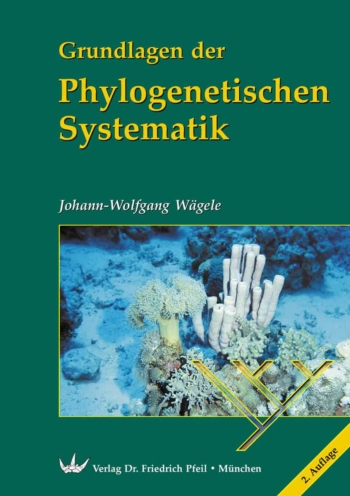
Grundlagen der Phylogenetischen Systematik
45,00 €zzgl. Versandkosten / Versandkostenfrei in D
-
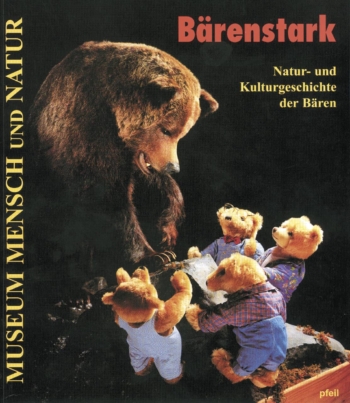
BÄRENSTARK (E-Book)
15,00 €zzgl. Versandkosten / Versandkostenfrei in D
-
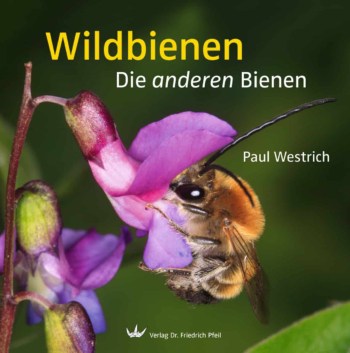
Wildbienen
19,80 €zzgl. Versandkosten / Versandkostenfrei in D
-

SAHARA
28,00 €zzgl. Versandkosten / Versandkostenfrei in D
Wir sind gerne für Sie da
Verlag Dr. Friedrich Pfeil
Wolfratshauser Str. 27
81379 Munich – Germany
Tel.: +49 89 55 28 6000
Fax: +49 89 55 28 6004
E-Mail: info@pfeil-verlag.de
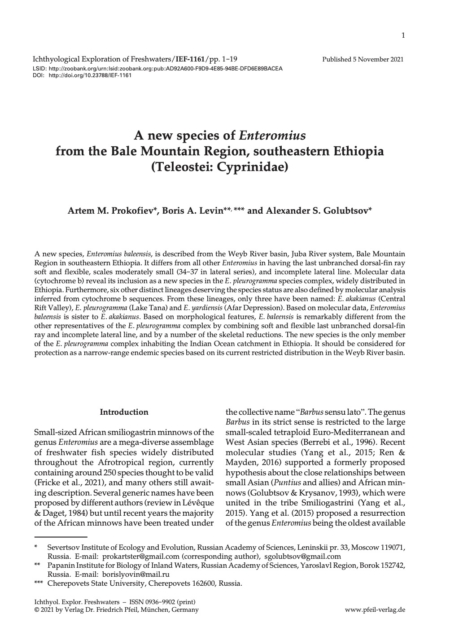
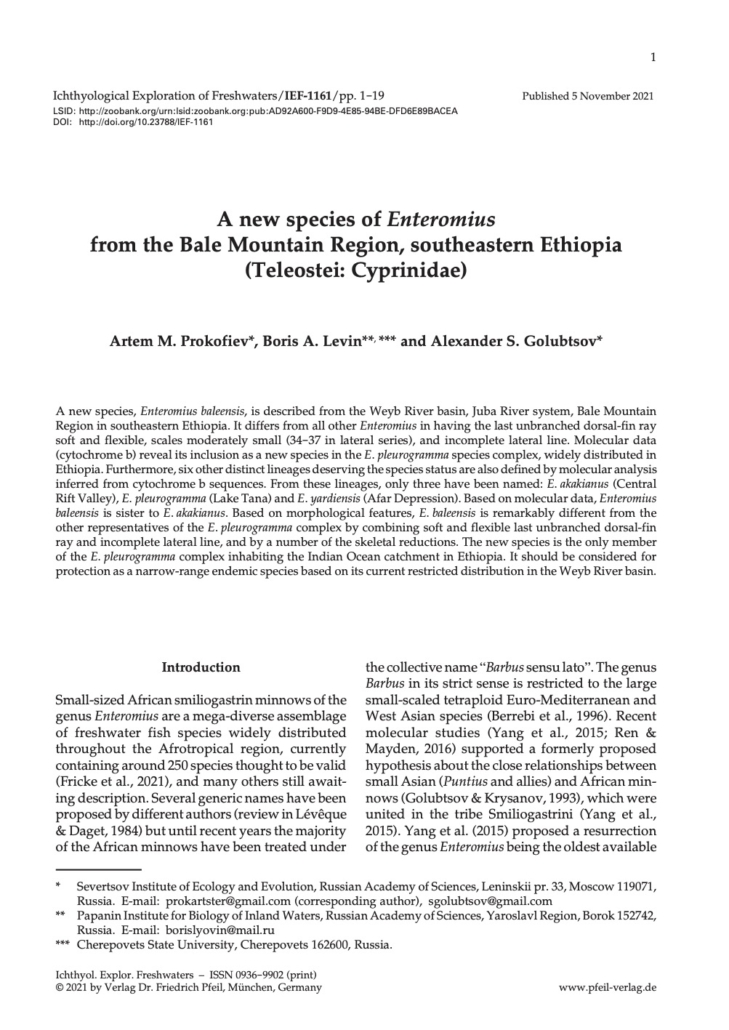
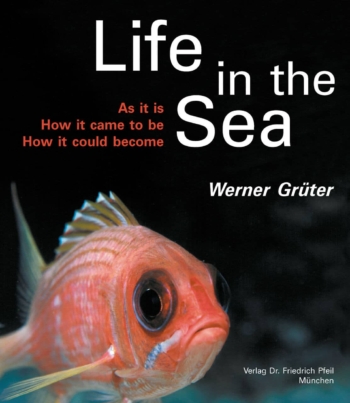
Bewertungen
Es gibt noch keine Bewertungen.